| |
|
|
|
|
Suffolk has no
motorways. There are A-roads, B-roads, and
a-long-way-from-any-other-roads, and it is by way of this
last category that you reach Wingfield, lost as it is in
the lattice of dog-legging, high-hedged lanes somewhere
between Eye and Halesworth. Despite its remoteness
Wingfield's church is well-known, but even if there was
no church, Wingfield would still be a place of
significance. It has a castle which isn't really a
castle, and a college which is no longer a college. It
was the combined power of these two, coupled with one of
the most powerful families in late medieval England,
which has given St Andrew the shape we find it in today.
And even if it was just the church, this would still be a
beautiful place to come, an elegant building of the 14th
and 15th Centuries set in a small, sloping, rambling
churchyard at a curve in the climbing road beside the
village pub.
The surprising quantity of 18th and early 19th Century
headstones suggest that the Wingfield estate was a busy
place in those days, and not a great deal seems to have
happened since. It is as if the sleepy air of this
backwater has had a soporific effect on the powers of the
seasons, the village, and even the passage of time
itself. But if the churchyard is a place to remember our
ancestors now just out of reach, St Andrew itself is a
document of the events, enthusiasms and urgencies of
longer ago, the Suffolk of more than half a millennium
past.
A pivotal and defining moment in English history was the
wave of virulent disease which swept western Europe in
the middle years of the 14th Century, for which the
Victorians would coin the popular phrase 'the Black
Death'. This outbreak of bubonic and pneumonic plagues
would, in the short term, carry off perhaps half the
population of East Anglia, but it was the economic
consequences which would have the greater effect in the
medium and long term. As the sons of the old landed
families were carried off by the pestilence, so the old
estates were broken up and sold off to a rising merchant
class. Land had bcome a commodity to be bought and sold,
and the fall in the population resulted in a shortage of
labour, handing economic leverage to the ordinary people
for the first time. A surplus of consumable produce, and
money to spend on it, meant that by the second half of
the 14th Century you can for the first time identify what
might be termed a middle class emerging in English
society.
The old feudalism was giving way to what was an early
form of capitalism. Families who rose to prominence
during this century became fabulously rich. They
exhibited their wealth in their houses and their
households, and exercised their piety in donations and
bequests to the Church, either in the form of buildings
and furnishings, or by paying for priests. Much of this
effort was aimed at ensuring the prayers which would be
said for them after they were dead. They hoped to escape
the long centuries in purgatory which many of them
clearly deserved. Part of this project involved an
attempt to reinforce Catholic doctrine in the face of
local superstitions and abuses, to make sure that the
ordinary people knew their duty. Ironically, many of
these families would, a couple of centuries later,
embrace firmly the new idea appearing on the continent,
Protestantism, and oversee a destructive Reformation in
the parish churches that their ancestors had built up and
beautified.
But that was in the future. Sir John Wingfield, whose
family had owned the manor of Wingfield for generations,
survived the Black Death, and perhaps as a form of
thanksgiving he established a college of priests here in
Wingfield in his will of 1361. The college buildings
remain at the heart of later buildings just to the south
of the church. Wingfield's personal fortunes had been
bolstered by marrying his daughter into one of the
parvenu families which rose to prominence in the 14th
Century. These people were merchants and traders in the
northern coastal city of Kingston upon Hull, nearly two
hundred miles away, but theirs was a name which would
come to be intimately linked with the county of Suffolk.
They were the de la Poles.
Wingfield's grandson, Michael de la Pole, Earl of
Suffolk, would inherit the Wingfield estates. He built
the fortified manor house known as Wingfield Castle, and
in the the early years of the 15th Century he oversaw a
massive rebuilding of the church. Only the low tower was
left from Sir John's day.
William de la Pole,
the first Duke of Suffolk, increased the family's wealth
by lending it to the Crown. But it is William de la
Pole's son that history remembers most. John de la Pole,
second Duke of Suffolk, was a notable figure in
Shakespeare's Henry VI parts I and II. Wounded
at Harfleur, he watched his brother die at Agincourt: All
my mother came into mine eyes and gave me up to tears. The
most powerful man in England, equivalent to both Prime
Minister and leader of the military, he surrendered at
Orleans to Joan of Arc in person, and his family paid
£20,000 for his release, roughly ten million in today's
money, but perhaps a drop in the ocean to them. On the
day before he died, he wrote a letter to his young son
enjoining him to look after his mother: Always obey
her commandments, believe her counsels and advices in all
your works. This message was received by the boy's
grandmother, who by virtue of her father's marriage was
granddaughter of the writer Geoffrey Chaucer.
Sir John Wingfield, his grandson Michael de la Pole and
John de la Pole the second Duke of Suffolk are all buried
here in the chancel at St Andrew. To reach them, you step
through the porchless north door into the nave. The porch
on the south side was likely intended to serve the
college, and is refered to in a bequest of 1450 when John
Bury left two nobles to its construction. As porches were
often the last piece of a building to be added this
probably gives us a good date for the completion of the
tower, nave and chancel. Other wills transcribed by Simon
Cotton and Peter Northeast for the following decades
confirm that the church was complete. These include John
Deye's 1452 bequest of 2s to the making of the
candlebeam, Thomas Cook's 1456 bequest of 20d to
maintaining the church, that is to say, the candlebeam,
and Margaret Deye's bequest of 2s to the new bell
in 1464. The parishioners of WIngfield were
enthusiastically furnishing their new church.
The nave is wide and
square, and full of light even on a dull day thanks to
the lack of modern glass. Only the floor tiles strike a
jarring note, for what was considered the height of taste
in the late 19th Century is now, rather unfortunately,
reminiscent of Burberry check. Passing the font, the eye
is drawn by the creamy light of the stone-faced chancel,
the arcades seeming to swell and soar as they head
eastwards to the drama of the great Perpendicular window.
The aisles continue eastwards to enfold the chancel, the
arches resplendent in motifs and riotous capitals. And
above, the clerestory does something extraordinary. What
had been a simple range of five evenly spaced windows on
each side above the arches, becomes a Perpendicular wall
of glass, seven windows on each side of the chancel
huddling together and picked out in brick which may well
have come from the de la Pole's works in Hull.
Conversely, the great range of aisle windows in the nave
continues into the chancel on the south side, but on the
north becomes sparser and erratic, leaving wall space for
monuments. For here was the final resting place of one of
medieval England's most powerful families.
A crocketed and canopied archway surmounts what is now
the vestry door, but was once the way into the chapel of
the Holy Trinity. Beside it, within a canopied easter
sepulchre, lies the effigy of Sir John Wingfield, founder
of the feast. Michael, Earl of Suffolk, lies across the
chancel between the sanctuary and the south aisle chapel,
his tomb set within the arch of the arcade. Beside him is
his wife Katherine, and their effigies are made of wood,
a fairly late example of the technique. An earnest little
lion sits up, alert, beneath his feet, and under his head
is a sleeping, bearded saracen, his mouth grinning in the
rictus of death. One of the most spectacular features of
the tomb is the way that the sedilia are built into the
northern side, which at once shows that the tomb is in
its original location, and also unites the de la Poles in
the sacramental liturgy of the church.
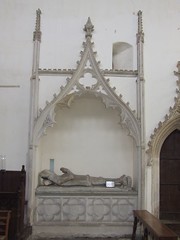  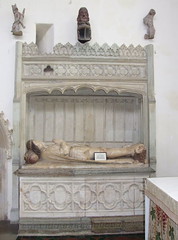 
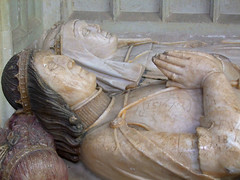  
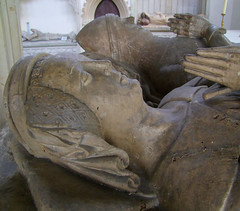 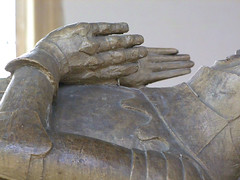 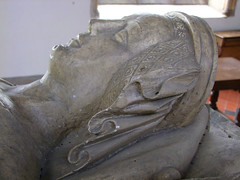
 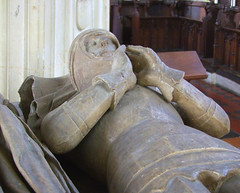 
   
But the finest
monument here is back across the chancel, on the other
side of the sanctuary and backing the wall to the chapel.
This is John de la Pole, second Duke. He lies in
alabaster beside his wife Elizabeth Plantagenet, sister
of Edward IV and Richard III. Their tomb echoes that of
John's grandfather, but there are subtle differences. His
iconography is the same, but the rendering of the images
has changed in half a century. Now, the lion is softer,
prouder, and the moor is startling and dignified. Beside
him, his wife, her pillow borne to heaven by flights of
angels, the tiny disembodied hand of one surviving
poignantly beside her as she sleeps.
St Andrew is a tale of two churches, a church of two
halves. Apart from perhaps Framlingham, no other chancel
in Suffolk is as magnificent as that of Wingfield, and it
does put the nave in the shade. The return stalls survive
from the days of the College of Priests, with misericord
seats and sombre heads on the hand rests, polished by
centuries of standing up and sitting down. Beneath them
is an acoustic chamber, as at Blythburgh, an early form
of amplification designed to add resonance to the voices
of those singing the offices.
But within a century, it was all over. The Reformation
did for the college of priests and prayers for the dead,
and the Anglican reformers comprehensively wrecked the
buildings which their ancestors had built up with such
devotion. What little remained was seen off by the
puritans a century later. To be fair, some of the
loveliest interiors in Suffolk are those which speak of
the 17th and 18th Century life of their buildings, but
here at Wingfield, the first response is to mourn what
must have been lost. Indeed, by the 17th Century this
chancel was derelict and disused, probably roofless. What
survives in the church from those years is ephemeral,
unexceptional, except perhaps for the hudd, a kind of
sentry box used by clergymen at burials in inclement
weather. The only other one I know of in East Anglia is
at Walpole St Peter in Norfolk.
The chancel was restored in the 1860s and then half a
century later it was reordered in an Anglo-Catholic
fashion with furnishings by the great Ninian Comper.
Incredibly, these were almost entirely removed and
destroyed in another refurbishment in the 1960s, and all
that survives of Comper are the candle holders on the
return stall. What we see today in any case is the result
of another major restoration in 1999.
So often in a quiet, rural backwater like Wingfield we
expect, and usually find, a humble church of the common
people, a touchstone to the blacksmith and the
wheelwright, the ploughboy and the farrier. Well, they
are all here - in the churchyard, they are all around.
But St Andrew is not a humble church. It is one of the
great English testimonies in stone, a story of power and
glory, of treachery and downfall. The Dukes of Suffolk
are no more, but still St Andrew rides the hidden lanes
of the county like a great ship, a ship of light. All
around, the 21st Century seems rather mundane and shabby
by comparison.
|
|
|
|
|

